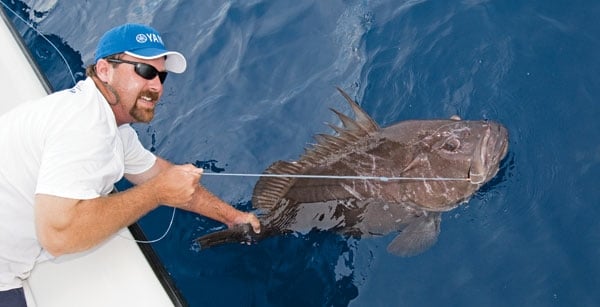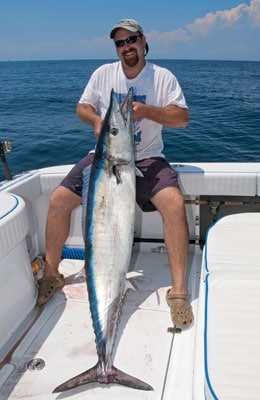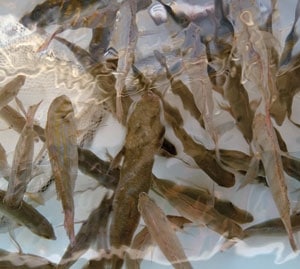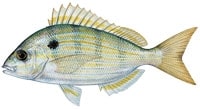
How important is live bait in the Gulf of Mexico? “It is the key to success,” says top tournament angler John Thomas Dusek. “If you want variety and quality in the fish box when you hit the dock, you’d better have a livewell full of good baits in the appropriate sizes for what you are after.”
That could not have been more evident than it was two Novembers ago when Dusek, my friend Brandon Smith and I left Freeport, Texas, with one thing on our minds: grouper. Actually, there were two things on our minds, and the first was catching the bait we needed in order to get on with the grouper.
Because we were all too busy to catch pinfish the night before, we departed with an empty livewell. Without the right baits, we were likely to waste a whole lot of gas. Dusek reminded us: “It can be tough to catch the smaller blue runners that we need for the scamps this time of year. That is why I like to have the piggies [pinfish] before we leave the dock.”
Fortune smiled on us that day, for at our first stop, at a rig about 60 miles out and in about 80 feet of water, the sounder lit up on several large schools of baitfish. “Use the small sabikis,” Dusek instructed. “We want only the little ‘crackers.'” An hour later, we had all of the bait we could use in a day and were off to a rig known only as “Sticky” to a close circle of friends.
Upon arrival, Dusek rigged with leaders that consisted of a swivel, a circle hook and a weight that could be described only as “man, that’s heavy.” Moments later, we were sending 5-inch blue runners to the bottom so fast that the amberjack and barracuda could not keep up.
“This one is getting licked good,” I informed all as the tip of my rod thumped up and down and I reeled in the first of what would be a perfect three-man limit: 15 scamp grouper between 18 and 22 pounds. It’s a feat not often repeated in the Gulf of Mexico, and the secret to our success was the perfect live bait.

Catching Bait
Often, the best offshore anglers are not the ones in the biggest boats with the priciest gear but those who are most competent at catching the right bait for the species they seek. I cannot tell you how many times I have been on a boat with Dusek and another friend, Casey Cundiff, and watched them catch bait when nobody else could. We might be at a rig with three other boats, filling our livewells with blue runners while other boats struggled to put a half-dozen in their wells. It is all about knowing what bait you need and how to catch it.
For example, if you are heading out to box a 50-pound king, a 5-inch blue runner or frozen ribbonfish will rarely do the job. To catch a big fish, you have to have a big, lively bait. A perfect example is the day we traveled over a hundred miles into the Gulf to tackle big warsaw grouper. We had only three big blue runners left, and all three were sacrificed to the fish gods when giant warsaws took the baits and headed into structure below. Our heads were low when Pat Varga, another one of Dusek’s regular crew, had an unusual idea: “Why don’t we try to catch one of these chubs and drop it down?”
Hordes of Bermuda chubs had been swimming around the hull of the boat all morning. At one point, we witnessed the chubs go into a panic as a giant blue marlin crashed through them only feet from the boat. The deduction: If they are tasty enough for a marlin, why would a grouper turn its nose up at one? So we threaded a cheese-flavored puff on a hook (chubs will eat anything) and dropped it over the side. Moments later, a 16-inch chub was on its way from the surface down to 400 feet, to be devoured by a 90-pound warsaw.
The chub was, of course, a good example of “big bait equals big fish,” but the standard fare will always be blue runners, or hardtails, as they are commonly known. And the key to catching them is to find structure, whether it be a rig, buoy or weed line, in 80 to 120 feet of water. The same theory applies to catching bait. If you are looking for foot-long blue runners for a big wahoo, amberjack or warsaw, break out the jigging spoons and get after them. However, if you want 5-inchers, just big enough that the bonito steal them from the blackfin tuna beneath shrimp boats, tie on a sabiki rig and bring them in four or five at a time. It’s important to have a variety of sizes and colors of jigging spoons and sabiki rigs, because baitfish can be picky too.
Another favorite food for many fish that swim in the Gulf is the cigar minnow. Unfortunately, it’s rarely available in any months other than September, October and November, and even then it can be difficult to locate. Look near structure in 70 to 90 feet, and use the smallest sabiki rigs. Cigar minnows, at 8 or 9 inches, are good for smaller fish. If you have bigger fish in mind, add a few big hardtails to the livewell.
There is only one other bait worth consideration, and that is pinfish, or as Dusek calls them, piggies. Pinfish can be caught inshore in one of two ways. The first is with perch traps baited with a couple of handfuls of shrimp heads and tossed into a channel. For a trip to the grouper grounds or for a blackfin trip, I suggest having at least three large traps or six smaller ones. Set them two days before heading out so you have time to move them if you need to. The second way to catch piggies is with a light rod, small perch hooks and dead shrimp on the jetties or near a fish-cleaning station. Carry a bucket and a battery-operated aerator to keep the baits in top shape.

Keeping Bait
When I started fishing in the Gulf of Mexico as a teenager, the rule was to carry a couple of boxes of squid to tip jigs, a couple of boxes of frozen cigar minnows to chum and drift, and a box or two of the biggest ribbonfish to drift. We caught the hell out of snapper, kingfish, dorado and cobia, mostly within 12 miles of the beach, out of an old Boston Whaler Outrage that was nothing more than a hull, motor, steering wheel and throttle. My, how times have changed.
Nowadays, we head into the Gulf in either Dusek’s 34 or Cundiff’s 42 Yellowfin to fish a hundred miles into the Gulf, but the boats still sport well-designed livewells. Many hard-core anglers are very particular about how their livewells are set up. Dusek is no exception. “On my old boat,” he told me, “I had a 30-gallon livewell with only one 800 gph pump, and I paid the price for it several times when the pump fouled and burned up.
“On my new boat,” he continued, “I wanted two wells which are at least 60 gallons, and for both to have dual 1,100 gph pumps on separate switches so if one fails, I can salvage the day.”
Dusek says it is important to have a livewell pump that circulates the water, but not so vigorously that it tires the baits. It is important to have an oxygen system on the boat to keep extremely large baits in good shape, especially during tournaments. As a rule, run no more than 800 gph for every 30 gallons of capacity.



Rigging the Baits
Every great offshore angler has a preference for rigging their baits. While cobia and tuna require nothing more than a heavy mono or fluorocarbon leader between hook and swivel, toothy critters demand more. For kingfish and wahoo, a wire bridle allows a bait to be drifted or slow-trolled without twisting. This rig usually includes one or two trailing hooks no more than 4 inches apart. Smaller baits require only one trailer, while large baits may require two. For bottomfish, 200- to 400-pound leaders are the norm. Carry a variety of hook sizes and a variety of weights for small and large grouper and amberjack.
Proficiency is the key to success. Those who are the most proficient at catching and keeping the best baits are the ones who show up at the dock wearing the biggest smiles. Whether you fish for fun or in tournaments, whoever has the biggest fish wins. Quality live bait is often the edge.









